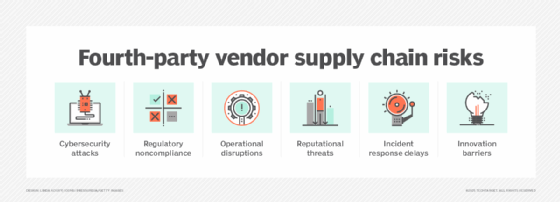What is fourth-party risk management (FPRM)?
Fourth-party risk management (FPRM) is the process of identifying, assessing and mitigating risks that originate from the subcontractors and service providers that an organization's third-party vendors use. These risks are distinct from ones that come directly from the third party itself.
When an organization outsources to a third-party vendor, that vendor might, in turn, depend on additional fourth parties, such as cloud platforms, subcontractors or software vendors. These entities, known as fourth-party vendors, play a critical role in the extended supply chain. The outsourcing organization doesn't have a direct relationship with these fourth parties, but their performance and security can affect the outsourcer's operations.
These indirect suppliers can introduce additional vulnerabilities, expanding the attack surface for potential threats, such as data breaches, regulatory noncompliance and service disruptions. These issues make fourth-party risk a key consideration in comprehensive risk management strategies.
Fourth-party vs. third-party risk management
Third-party risk management focuses on assessing and mitigating risks associated with direct vendors, suppliers and service providers that an organization engages with. These risks include cybersecurity vulnerabilities, regulatory compliance issues, operational failures and financial instability.
Fourth-party risk management extends oversight to the broader vendor ecosystem. It ensures businesses account for risks originating from the external entities their third-party vendors use. Since organizations often lack direct supply chain visibility or control over fourth parties, managing these risks requires monitoring vendor vulnerability disclosures, reviewing System and Organization Controls (SOC) reports, and ensuring third parties conduct thorough due diligence.
Why is fourth-party risk management important?
As enterprises increasingly rely on third-party vendors, the complexity of supply chains grows. FPRM offers visibility and oversight needed to understand who is handling the outsourcing organization's data besides the direct vendors. It helps assess the risk concentration from shared public service providers, such as Amazon Web Services and Microsoft, and also ensures appropriate controls and contingency plans are in place.
By adopting fourth-party risk management, organizations can gain better visibility into their entire supply chain. They can also identify potential vulnerabilities, enforce strict security standards at all levels of their supplier network, and ensure appropriate controls and contingency plans are in place.
Different categories of fourth-party risk
Many businesses diligently assess their direct vendors; however, they often neglect the broader ecosystem. There, unseen fourth parties can introduce significant risks, such as the following:
- Cybersecurity threats. Cyberattacks most often target the weakest link in a supply chain. Weak and overlooked security measures in fourth-party networks can lead to data breaches and supply chain attacks.
- Regulatory compliance issues. Hidden subcontractors might not comply with industry regulations, such as the Health Insurance Portability and Accountability Act or General Data Protection Regulation. Failure to account for fourth-party risks can lead to negative consequences, including regulatory penalties and legal actions. For instance, if a fourth-party vendor fails to secure sensitive data and a breach occurs, the organization relying on that vendor might be held accountable under various regulations and laws.
- Operational disruptions. Critical fourth-party failures can affect service delivery. For instance, if a fourth-party supplier experiences a disruption, it affects the operations of an organization that relies on its third-party vendor, ultimately hindering business continuity.
- Reputational damage. Poor practices among fourth-party suppliers can affect an outsourcing organization's public image and reputation. Customers and partners expect secure and reliable services, regardless of how many layers of vendors are involved.
- Delayed incident response. Without knowledge of who the fourth parties are, incident response teams can't act fast enough to contain issues and notify stakeholders. Recovery time and damage can also be extended due to lack of awareness.
- Innovation bottlenecks. If third-party vendors depend on outdated or rigid fourth-party technologies, it can often limit an organization's ability to innovate, adopt new capabilities and respond to market changes.

How to identify fourth parties
Organizations can identify fourth-party vendors by thoroughly examining the SOC reports of their third-party providers. These reports help uncover subcontractors and assess whether their security and compliance practices align with industry standards.
SOC reports outline how vendors safeguard sensitive customer data and prevent unauthorized access to personal information. There are two main types of SOC reports:
- SOC 1. A SOC 1 report verifies that an organization has established cybersecurity risk management controls as of the date of the report. It focuses on a vendor's internal controls related to financial reporting. Businesses involved in financial transactions, particularly those engaging with external stakeholders, should conduct SOC 1 audits regularly to ensure compliance and security.
- SOC 2. A SOC 2 report evaluates how well the controls defined in a SOC 1 report function over time. Typically spanning six months to a year, this report assesses whether these controls are consistently effective in real-world operations.
In addition to SOC reports, the Statement on Standards for Attestation Engagements No. 18, or SSAE 18, is a set of auditing standards introduced on May 1, 2017. It requires third-party vendors to disclose their critical subcontractors in SOC reports, enhancing transparency in fourth-party identification and prioritization.
Key steps to implementing a fourth-party risk management program
When adopting FPRM, organizations must evaluate several factors. A well-structured vendor management program plays a crucial role in ensuring effective oversight. Key aspects of managing FPRM include the following steps:
- Visibility and mapping. Organizations should identify all the important fourth parties within their supply chain to effectively manage fourth-party risk. This involves creating detailed relationship maps that outline connections between third and fourth parties, visualizing dependencies and risk areas. Understanding these dependencies and interconnections lets businesses assess vulnerabilities, strengthen oversight and ensure operational resilience.
- Third-party due diligence. Organizations typically rely on third-party vendors to assess fourth-party risks effectively. Fourth parties should be held to the same standards as direct vendors, so organizations need to ask third-party vendors questions about the fourth party's risk management practices. These include reviewing business continuity and disaster recovery plans to ensure they align with organizational needs, evaluating the fourth party's SOC report and control objectives, and analyzing financial statements from the past three years. Verifying legal and regulatory compliance, identifying and addressing due diligence concerns, ensuring ongoing risk assessments, and requesting evidence of vendor risk reviews can strengthen oversight and mitigate potential vulnerabilities.
- Risk assessments of fourth parties. Organizations must carefully evaluate the threats posed by fourth-party entities, including cybersecurity vulnerabilities, compliance challenges and financial instability. Risk tiering should be used to classify fourth parties based on the type of service they offer and their regulatory and compliance capabilities. Organizations should also analyze concentration risks, where multiple vendors rely on the same fourth party, as this could amplify the consequences of an issue within the supply chain.
- Contractual controls. To effectively manage fourth-party risk, organizations should ensure that third-party contracts incorporate oversight provisions for fourth parties. This includes establishing right-to-audit clauses that enable periodic assessment of vendor relationships and security practices. In addition, clearly defining security and compliance requirements within contracts helps maintain regulatory adherence and mitigates potential risks throughout the extended supply chain.
- Incident response and business continuity. Organizations must ensure that both their third-party vendors and the fourth parties those vendors rely on are included in incident response and business continuity planning. This could mean requiring vendors to have documented plans for how they respond to cybersecurity incidents, operational disruptions and data breaches.
- Continuous monitoring. Organizations use continuous monitoring to proactively identify and mitigate risks in their vendor ecosystem. By using real-time data, threat intelligence feeds and automated tools, they can track potential vulnerabilities in their fourth parties. Monitoring systems can flag patterns, such as a fourth party experiencing repeated security incidents or failing regulatory audits, so businesses can take swift corrective actions.
- Collaboration and communication. Effective collaboration between an organization and its third parties ensures that fourth-party risks aren't overlooked. Companies must work closely with their direct vendors to establish transparency, enforce vendor risk management protocols and require clear subcontractor reporting. Without structured communication channels, organizations struggle to obtain critical information about their extended supply chain, making them vulnerable to security threats, financial instability and compliance failures.
FPRM challenges
Fourth-party risk management is becoming increasingly complex because of evolving regulatory requirements, expanding vendor ecosystems and heightened cybersecurity threats. In 2023, SecurityScorecard analyzed the cybersecurity profiles of 240 major financial institutions in the European Union, including their third- and fourth-party vendor operations. Its report on the Digital Operational Resilience Act revealed that 78% of surveyed financial entities faced cyber-risk due to third-party breaches, while 84% were exposed through fourth-party breaches.
Here are some key challenges organizations face when dealing with FPRM:
- Limited visibility. Since fourth parties are subcontractors of third-party vendors, organizations often lack direct access to their risk assessments and security controls. Complex organizational structures further obscure dependencies, with hidden connections emerging unexpectedly. These visibility gaps make it difficult to assess fourth party risks, leaving businesses vulnerable to disruptions and security incidents from unknown fourth-party relationships.
- Increasing supply chain complexity. The growing rate of globalization and outsourcing has created multi-tiered supply chains that are hard to map and monitor. Dependencies between vendors and their suppliers introduce hidden points of failure and make it challenging to manage FPRM.
- Operational dependencies. Operational FPRM dependencies happen when multiple third-party vendors rely on the same fourth-party providers for essential services. This creates concentration risk, where a disruption cascades across multiple vendors, affecting an entire supply chain. For example, if several third-party vendors depend on a single cloud service provider for data storage, an outage or security breach at that provider would affect multiple third parties.
- Limited control and enforcement. Most organizations have no direct contractual or legal authority over fourth parties. This makes it difficult to enforce security standards or audit rights unless such provisions are explicitly included in third-party agreements.
- Lack of real-time monitoring tools. Unlike third parties, fourth parties are one step removed, making oversight difficult. Organizations often don't have the appropriate tools to monitor their indirect vendors in real time. Traditional tools can miss these entities, leaving compliance and breach blind spots. Without process-built FPRM tools, organizations remain reactive and vulnerable to extended and hidden supply chain risks.
Where is FPRM headed next?
Fourth-party risk management is evolving rapidly as organizations recognize the expanding scope of their supply chain vulnerabilities. AI is revolutionizing FPRM, making real-time monitoring a standard for continuous supply chain risk assessment. The rise of generative AI is further enhancing detection methodologies, providing deeper visibility into vendor ecosystems. These advancements mark a shift from periodic evaluations to dynamic, always-on monitoring, enabling organizations to identify risks before they escalate.
As fourth-party dependencies grow more complex, organizations are demanding greater contractual transparency to mitigate hidden risks in vendor ecosystems. Traditionally, businesses had limited visibility into their vendors' subcontractors, leaving them vulnerable to operational disruptions, compliance failures and cybersecurity threats originating further down the supply chain. Updated contract terms can require vendors to disclose their subcontractors, ensuring better oversight and control over fourth-party relationships.
Effective FPRM relies on having good third-party oversight. Find out how to build a third-party risk assessment framework.







